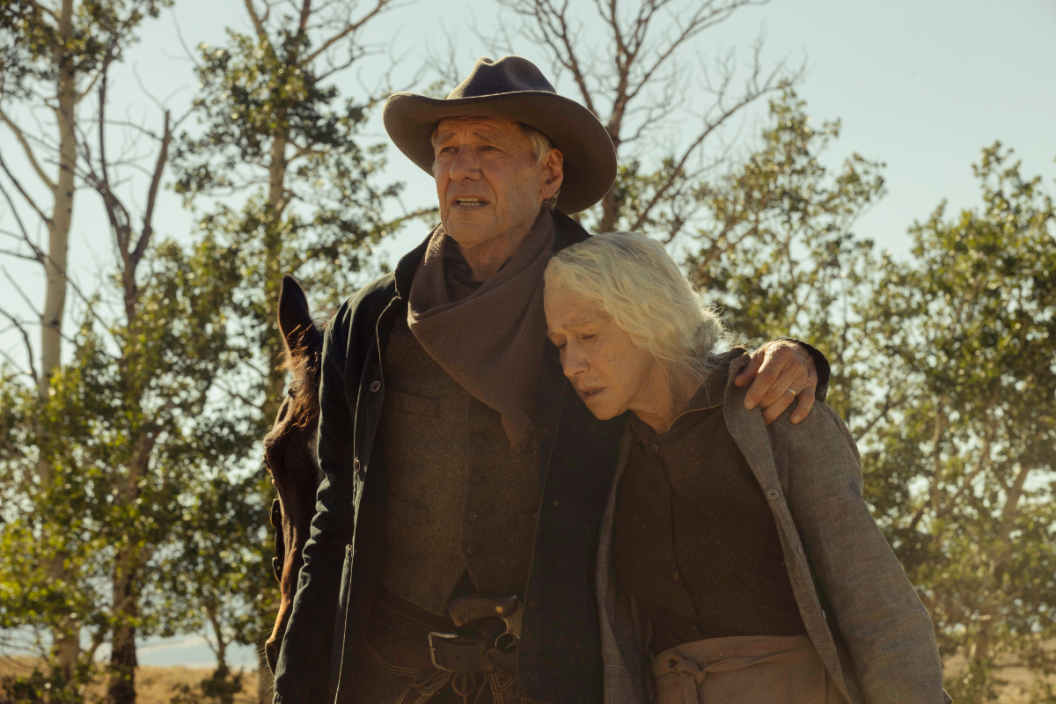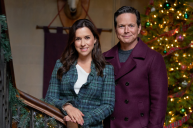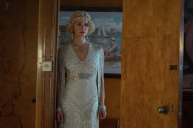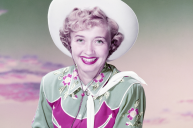You might not know Janie Bryant's name, but you certainly know her work. The costume designer started making some waves with her Emmy Award-winning work on HBO's beloved (and all too short-lived) series Deadwood, but really broke out with her work on Mad Men. Since then, she's designed the look of It and costumed The Romanoffs, but she's also crafted all the fashions featured on both Yellowstone prequels, 1883 and 1923.
She'll be talking about the latter Saturday, April 29 at the Paley Center in New York City, where she'll be in conversation with Queer Eye alum and RuPaul's Drag Race judge Carson Kressley. Prior to that event, though, Wide Open Country sat down with Bryant to talk about the history of western wear, safari wear vs. ranch wear, and why she opted to make Helen Mirren a vision in blue.
Wide Open Country: You worked on Deadwood so you're no stranger to the wild west, but how did you come to get involved with the Yellowstone spin-offs?
Janie Bryant: I did design Deadwood, which was set in 1876, and then I did the movie, which was set 10 years later in 1886. It's very different designing 1883 and 1923, though. Just in contrast, in terms of time period, cowboys had not come to Deadwood yet. Cowboy culture is completely different than prospector culture, which is really what I did for Deadwood. So with every show that I design, I learn a lot. I do a lot of research and learn about different cultures.
That's one of the things that I love about costume design, and especially that I love about working on 1923. It's not only about Western culture, it's also about European culture and South African culture. American Indian culture! That's a huge part of the Yellowstone shows as well, which is one of my favorite parts of the job. I've loved working with the Native American consultants and cast and just learning so much.

Christopher T. Saunders/Paramount+
Wide Open Country: It's certainly a lot to research. What was your process and how did you keep it all straight?
Janie Bryant: Well, I try to keep it straight. With 1923, it's really just about taking one bite at a time because it's so big. It was really important for me to take it a day at a time in terms of planning ahead.
Really, it was so important to design all these different worlds and show all those different cultures and all those different people. I think a good example of that is Helen Mirren. Her character really dresses in a very old-fashioned style, where she looks like she's from the early 1900s or 1910s. Her design is not 1920s. I envisioned her character to be pretty old-fashioned, and Helen envisioned her character to be that way too. And so that's why her costumes and her look is many years behind.
Just learning about British culture and the British people going down to South Africa and other parts of Africa for hunting, that was a big research process. That's true about what was happening in cowboy culture in the 1920s in Montana and what was going on at the Native American schools at that time period too.
I was kind of plotting and putting together all the different extras, too, because there were thousands of extras on 1923. I love extras, too, because I really feel like they set the tone. They're such a big part of the setting, especially in a period piece. Doing the extras was pretty epic, as well as designing for all the principal cast.
Wide Open Country: How often were you pulling new items to craft the looks and how often were you sourcing vintage material? Original clothes from the '20s exist, after all, but they're certainly harder to find.
Janie Bryant: The '20s are really hard to source because everything is 100 years old and it's also a period of very delicate fabrics. There's a lot of chiffon and a lot of beading on the chiffon. Velvets haven't usually made it through time that well.
A lot of things we did buy that were 1920s came from my different vintage vendors, though. I design most everything for the principal cast, and we build it. And then for the background extras, we do a lot of rentals. I find that designing any period show is like that. I design, we build the costumes, source the fabrics, we do rentals, we buy as much as we can for the period, and it's always that combination. There's not enough time and not enough money to build every single piece of clothing for every single character, extra, and day player.

Emerson Miller/Paramount+
Wide Open Country: And this is ranch life, this is Safari life, this is life on the road... Spencer's a sweaty, dirty guy. Are you aging his clothes? Are you changing them over time? Do you have different versions of the same shirt? Can you talk about that process a little bit?
Janie Bryant: A big part of the story that [creator] Taylor [Sheridan] wanted to convey is that Africa's really, really, really hot, so the sweat was really important to have for Spencer and for his team. We had to apply aging and sweat, and different versions of sweat and different versions of distressing like when he got blood on his shirt or the shirt was torn, or the pants were torn.... We had many, many, many multiples of his looks so that we could basically paint on whatever dirt, sweat, or blood we needed to put on them.
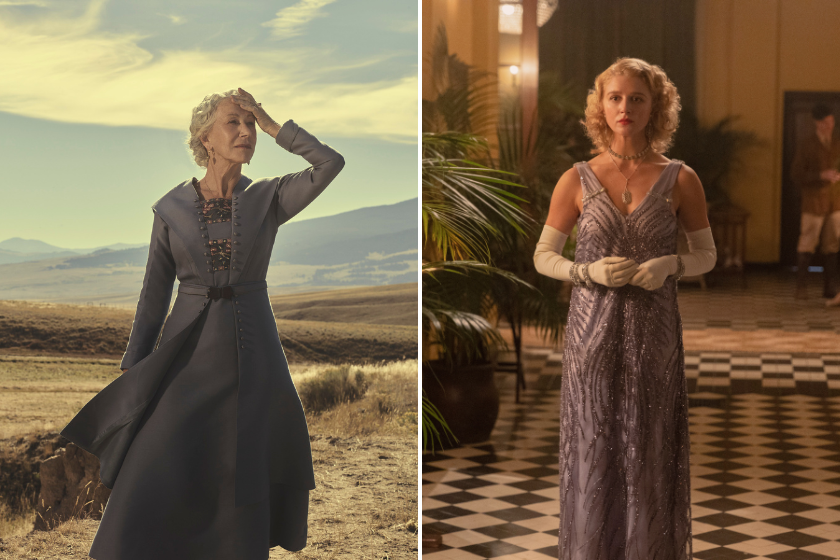
James Minchin III/Paramount+ / Emerson Miller/Paramount+
Wide Open Country: Did you have favorite outfits from this past season?
Janie Bryant: Oh my gosh, yes.
I love Helen's blue wool dress. I designed it for her and I love it so much because when I was designing for 1883, Taylor shared that he really wanted Elsa to be in something blue. He always envisioned her palette to be blues and yellows, and so I designed the blue day dress for her that she wore on the train. That dress then goes into different phases where she's ripping off the sleeves, cutting off the Polonaise, and all these different kinds of things happen to the dress, but Elsa is the character who is hopeful. She's optimism. She's hope for the future. She's like the sky.
That's why I made a dress for Helen that was in that same palette because I feel like Cara is the hope of 1923. She is the optimism, she is the air, she is the maternal savior that keeps the family together. So, I love that Elsa and Cara have that similar color palette, especially in the beginning of the show.
I also really love Alexandra's purple evening gown that I designed. She wears it before she runs away. I love that dress so much not only for the color, because I love that lavender on her, but also because we made that dress in my shop in South Africa. There was one fabric store where we were in Durban, and so it was a challenge to source fabric that looked like our period. That was basically the one fabric and the one color because Taylor had said to me, "Oh, I love lavender for Alex's character." So it was the only lavender that I found and the only fabric that had a very 1920s beading vibe. That dress was a great success. I thought it told the story of her character so well in that scene.
I love Alexandra's safari costume too. One of my favorite shots in the whole show is Alexandra running after the car. Her Hermes scarf is flying through the wind, and she's running so fast with her little bag. You just see the life of this girl and what she's jumping into. That's why I love her costume, too.
Wide Open Country: It's interesting because I think we all have this perception of what 1920s style was, but you had to think about what it was like in Montana, and what might have made it there versus what the aristocracy wore, and all that. It had to be a challenge.
Janie Bryant: Well, it's interesting because we did a lot of research on what people were wearing in Bozeman in 1923. Most of the women had already cut all their hair off.
The 1920s were a real rebellion. Gone were the corsets, no more tightening... It was much more about the boyish silhouette. It was not really a period of accentuating femininity, hence cutting off the hair.
I call the 1920s an arts and crafts period because it has these quirky little eccentricities in the beadings and the details and the pairing of this very straight silhouette with wearing silk, soft foundations, and cutting off their hair.
It was happening in Bozeman for sure, too. And you know, the dresses of the early '20s were really long too. The early '20s is not the flapper period. The early 1920s were definitely pre-flapper.
Wide Open Country: Let's talk about your conversation at the Paley Center. Have you met Carson Kressley before? He's all about classic American style.
Janie Bryant: I cannot wait to see Carson because I haven't seen him since I was designing Mad Men. I remember I was at this award show to receive the Hollywood style award, and I was doing the red carpet, and he was there. He was interviewing people, and I had redesigned this 1980s cocktail dress, and it was seafoam. He was like, "Well, aren't you a vision in seafoam?" And that was the only time I met him. I haven't seen him in a very long time, and he may not even remember that he met me, but I will never forget that because it was seafoam, but it was fabulous.
Wide Open Country: Why do you think Western fashion is such an enduring look? So many things from ages ago—denim pants, pearl snap shirts, boots—are all still around and are all still in fashion. Why do you think it's such a quintessentially American style?
Janie Bryant: I think Western wear represents American freedom. It's that kind of American dream and rebellious spirit. People romanticize all of those things, and that's why I think Western wear is always in fashion. It is part of that American spirit of the frontier, the conquering, the land. The great success of America. Western wear really represents all those things to people, and I think it'll always stay in fashion because it is so iconically American.
READ MORE: The Women of 'Yellowstone' & '1923' Trade Their Jeans and Boots for Glam Gowns in Stunning Photoshoot
